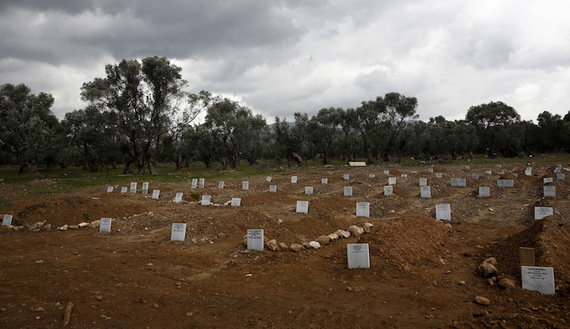
Izmir has been one of the main departure points for refugees seeking to cross from Turkey to Greece. Syrian families sleeping in parks and traffic islands had become a common sight across the city in the crisis days that led up to the Turkey-EU agreement to stem the flow in March. A "refugee industry" flourished in the city, including underground workshops manufacturing dinghies — often unseaworthy — and fake life jackets filled with non-buoyant material. Even shops on main streets sold life jackets and other supplies the refugees needed for their journeys, as Syrian child beggars became a fixture in the streets and better-off Syrians sent rental prices soaring.
Those sights have now disappeared, with Turkey tightening control on its Aegean coastline since signing the deal with the European Union. For many refugees, however, Izmir has become a final resting place.
In a large cemetery in the district of Dogancay, a plot adjacent to the potter's field is being used as a burial ground for refugees. Hakan Yildirim, who has worked as a grave digger here for the past six months, was the first person Al-Monitor met upon entering the ground. Yildirim, 17, recalled how bodies used to come every day in the winter months. "One day 12 bodies were brought at once. They were said to have drowned when their boat sank. The bodies had been washed and shrouded. The imam said prayers, and we buried them. There was no one else. There were three kids among the dead, and my heart went out especially for them," Yildirim said. The arrival of bodies, he added, has phased out in the past several months.
The cemetery's manager, Imam Mustafa Ozer, told Al-Monitor that 158 refugees had been buried so far, including 62 men, 41 women, 30 boys and 25 girls. The ground was bedecked with greenery a few months ago, and each grave was tidily encircled with tiles and garnished with flowers. Hence the "exemplary cemetery" label it has earned from some Turkish media.
Ozer explained the bodies were brought for burial after no one claimed them during a 15-day waiting period at the Forensic Medicine Institute. "We performed the funeral prayers, but there was no funeral congregation for any of them," he said.
Adults and children are buried in separate sections. Grave digger Erdem Isik, who has dug the graves of dozens of refugees, pointed somberly to the children's section and said, "I felt so sad while burying the children. They were just kids unaware of what they were going through. They probably saw everything as a game, even when their boat was sinking. So blameless and innocent they were."
The nameless graves have wooden signs inscribed with consecutive numbers. Refugee number 42277 lies next to refugee number 42278 and so on. Only two proper marble tombstones stand out, reading "Diana Nazari from Afghanistan" and "Meryem Ahmedi from Afghanistan." According to Isik, the graves belong to two girls, ages 4 and 8, who died in the hospital. An association helping refugees took care of them while they were hospitalized and later had the tombstones erected. No relative has since come to visit the graves. "And who is supposed to come anyway? Their families have probably all perished," he said.
Several other graves are also identified with names inscribed on metal signs. Souad Saleh Farran from Syria, for instance, was among 31 refugees who drowned in a boat that sunk in the Aegean Sea Jan. 5. According to her cousins, who managed to locate the grave months after the tragedy, Farran was a mother of four, who got divorced six years ago because of persistent domestic violence. She then enrolled at Damascus University to study law, but the war disrupted her aspirations. She died while trying to reach Germany, where her son was a university student. Farran's relatives identified her from pictures kept at the local prosecutor's office. The metal sign was the best they could do to pay a final tribute.
Ozer showed Al-Monitor another section of the burial ground that had served temporarily as a final resting place for refugees who died fleeing the war in Iraq. "After the war in Iraq ended, people came and identified [the graves of] their relatives from records at the prosecutor's office. One by one, they took the remains back home," the imam said. "No Iraqi refugees are buried here any longer." He believed the Syrians would do the same. "People will come when the war comes to an end, which I hope will happen soon," he said.
Ozer explained the prosecutor's office kept files of the dead, including pictures, which helped relatives to identify graves. Yet only a handful of dead people had been located in this way so far.
As Al-Monitor was leaving the cemetery, Yildirim, the young grave digger, came over, eager to say something else. "I forgot to tell you," he said, "I buried two Syrian babies here three weeks apart this month. But the funerals were not without congregation. Their mothers were there. I was told they had died from hunger and destitution."



Reader Comments
to our Newsletter